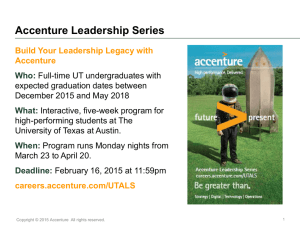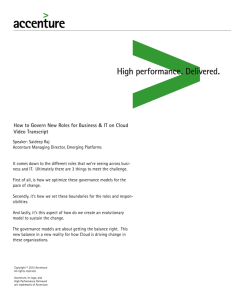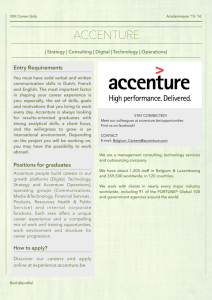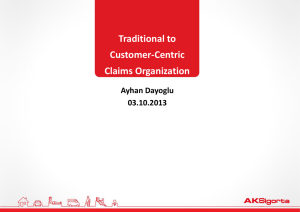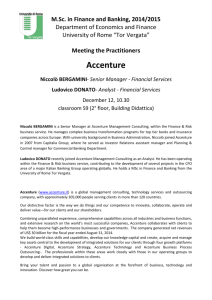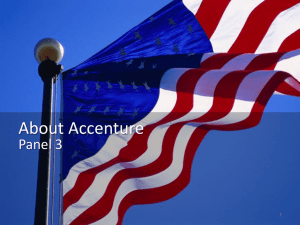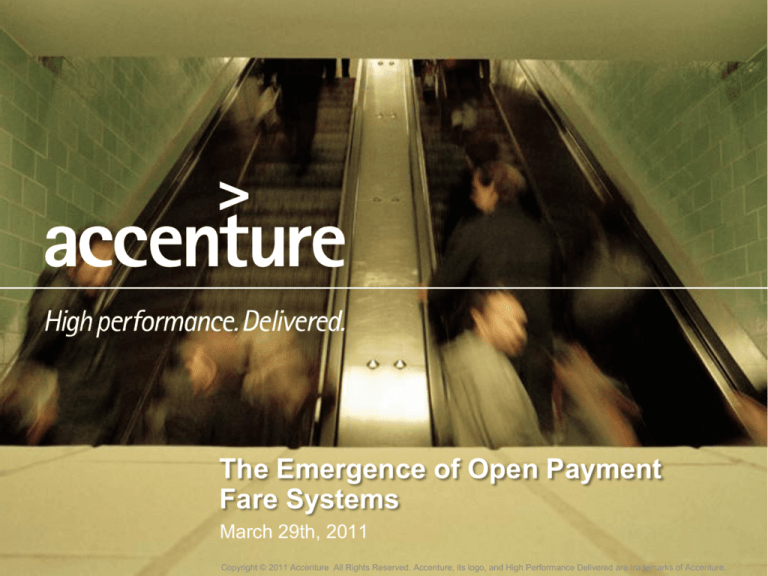
The Emergence of Open Payment
Fare Systems
March 29th, 2011
Copyright © 2011 Accenture All Rights Reserved. Accenture, its logo, and High Performance Delivered are trademarks of Accenture.
Agenda
• A walk down memory lane
• Customer choice and the retail experience
• Today and tomorrow
• Open payment does not equal open system
• Always think from your customer’s perspective
• And then there was mobile
• Summary
Copyright © 2011 Accenture. All Rights Reserved.
1
A walk down memory lane
While Smart Transit Cards remain mature, flexibility is key given the uncertainty of
customer preferences towards future technologies.
1997
1998
1999
2005
2006
2007
2008
2009
2010
NFC-enabled cell phones
Mobile Suica NFC Mobiles
(Tokyo)
(Bordeaux)
Indicators of future direction
Touch & Travel
(Germany)
Contactless bank cards
Pilots (New
York & Utah)
Operational
System (Utah)
Multi-application cards
Citi SMRT, Citi Octopus
Transit application cards
Octopus
(Hong Kong)
Breeze
(MARTA)
2011+
• TLS
• Giesecke and Devrient with O2
Indicators of future direction
•
•
•
•
•
TfL
New York (piloted)
SEPTA (in procurement)
CTA (in procurement)
WMATA (in procurement)
Indicators of future direction
Oyster
(London)
Copyright © 2011 Accenture. All Rights Reserved.
OV-Chipkaart
(Netherlands)
PRESTO
(Ontario)
• ITSO/DfT
• APTA CFMS
• EU & UITP IFMS
2
Retail trends are influencing transit
Customer are looking for expanded choice and convenience enabling a broad
range of needs and preferences.
• Access information from
multiple interfaces
• Anytime, anywhere, anyplace
• Solutions that
are low-cost
and affordable
• Single or multiride, pass,
stored value
Copyright © 2011 Accenture. All Rights Reserved.
Choice of
integrated
transit
Choice of
access to
information
• Multiple transport modes and
operators (public/private)
Choice of
payment
channels
Choice of
produce
and service
• Options on how to pay and use
transit
• Credit card, debit card, mobile,
stored value card
3
3
Driving evolution in transit and transportation
Transit today
Transit tomorrow
Enablers
• Customer first
focus
• Flexible business
models
• Limited fare acceptance
options
• Operating inefficiencies
• Barriers to regional transit
interoperability
• Reduced customer access to
transit
• Proprietary
technologies/hardware
• Cost-prohibitive
modernization options
• Retail industry orientation
• Expanded partnerships
• Payments evolution
• Open standards and
architecture
• Business
outcome vs.
device focus
• Customer choice and
convenience
• Operating cost efficiency
• Product and service flexibility
• Integrated transit and
transportation
• Enable public policy agenda
• Broader partnerships (public/
private)
• Flexible technology and
infrastructure
• Limited business intelligence
Copyright © 2011 Accenture. All Rights Reserved.
4
Open Payments requires an open system and
architecture focus
Financial Services
Agency
Authorize/
Issuing Bank
Acquiring Bank
Transact
Card
Service
Funds
Funds/
Transfer
Agency
Bank
Authorize
Transfer
Settle
Customer
(Cardholder)
Devices
Common Systems
Customer
Config/
Transact
Transact
Config
Calculation
Revenue Protection
Customer Service/Marketing
Authorize/Transact
Copyright © 2011 Accenture. All Rights Reserved.
Monitor &
Report
Financial
Analytics/Reporting
Authorize/
Fare
Policy
5
Always think from your customer’s perspective
Be socially inclusive
• Unbanked to affluent ridership
• Broad range of product offering
Be aware of how customers use products
• There is not one product that produces every solution
• Needs differ depending on how the system is used
Be careful of what you implement
• Understand the fine print
• Certain instruments may impose fees on those who can ill afford to pay
Copyright © 2011 Accenture. All Rights Reserved.
6
And then there is mobile…
Stage 1
Phone as an interactive payment
device
Stage 2
Phone as a sales and delivery
channel
Functional Scope
• Phone as a Card, used for
check-in/check-out
• Read-only user interface to see
products, e-purse value, last
transactions
• Physical issuing of NFC
application
Functional Scope
• Phone as a Delivery channel,
over-the-air provisioning and
reload
Key Business Driver
• Introduce innovative fare media
• Get feedback from end-user
Requires
• NFC mobile phones/adapters
Copyright © 2011 Accenture. All Rights Reserved.
Key Business Driver
• Enhance customer experience
by enabling real-time end-toend process
• Reduce delivery costs and
extend delivery network
Requires
• Network & infrastructure,
mobile applications, TSMs,
financial integration
Stage 3
Cross-sales and smart tags
Functional Scope
• Phone as an enhanced Point of
Sales, integration with card
usage history and reminders
• Timetable integration, Payment
integration Touch & Travel
• Phone as a Cross-sales
channel, a smart tag reader
Key Business Driver
• Increase sales and reduce sales
costs
• Expand scope of services
Requires
• Transit and wider non-transit
mobile cross-sales adoption
7
In summary
• Traditional suppliers’ systems are not as open and flexible as may be claimed =>
locked into to one solution
• True open architecture ensures systems are flexible, adaptable, configurable,
scalable as defined by the needs of the agency/region => not dictated by the
supplier
• Users want convenience and ease of use and a reliable service => choice at a
reasonable cost
• There is no one panacea => combination of solutions leading to a systems
integrator focus
Copyright © 2011 Accenture. All Rights Reserved.
8
Brian Stein
Business Development Lead, Public Transit
Accenture
brian.stein@accenture.com | 617.291.7282
Copyright © 2011 Accenture. All Rights Reserved.
9

